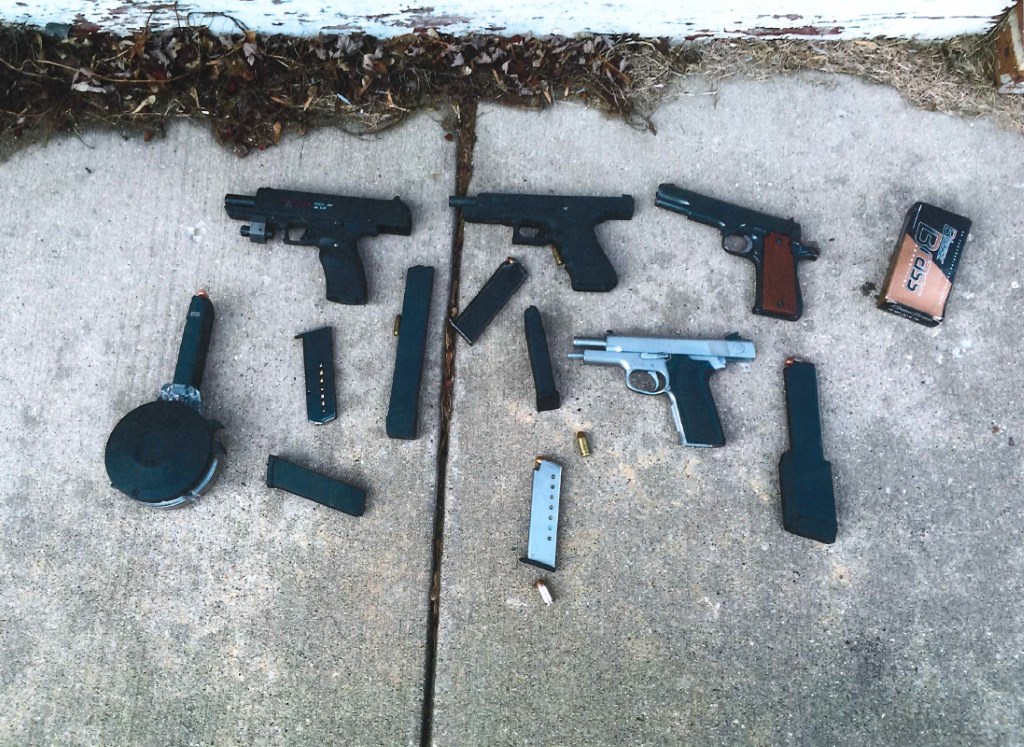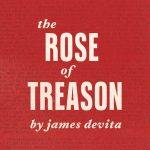The More Guns, Less Crime Scam
Questionable research shows Right To Carry reduces crime. Here’s the full story.

MPD recovered several guns and tons of ammunition from one criminal who’s guns were supplied by his brother, who had a CCW permit. Photo courtesy of the Milwaukee Police Department.
Twenty years ago, in 1997, the Journal of Legal Studies published a paper by John Lott and David Mustard. In it, Lott and Mustard reported their findings that violent crime went down after states passed laws allowing their residents to carry concealed weapons. This counter-intuitive finding helped fuel the campaign for similar “Right-to-Carry” (RTC) laws in more states, including Wisconsin.
Lott and Mustard claimed these results came as a surprise, suggesting they were unbiased researchers just looking for empirical evidence. Since then, however, Lott has become a true believer. A glance at his website shows he has become an outspoken advocate for the “more guns, less crime” position. In fact, that is the title of one of his books.
The Lott-Mustard conclusion may have been more influential because of its timing. In 1996, under pressure from Congress and the National Rifle Association, the U.S. Centers for Disease Control and Prevention stopped funding research on firearms. Without the prospect of federal funding many researchers likely decided to pursue other topics.
Even so, a number of concerns were raised doubts about the Lott-Mustard conclusions. One was that the period they studied initially was the height of the crack epidemic. States passing new RTC laws were in the South, whereas northern cities were hard hit by the explosion of crack use. Several researchers looked at trends in later years and found that the passage of RTC laws was actually associated with higher crime.
Despite criticism, Lott’s conclusion was widely influential. First, it was widely used by supporters of bills loosening restrictions on carrying weapons. In addition, it likely encouraged people to buy and carry a gun, particularly residents of dangerous neighborhoods that carrying a gun made them safer. Finally, it backed the argument that any restriction on guns, while well-meaning, is counter-productive.
Isolating the effects of a single public policy is often tricky at best. If there is a difference in crime rates between states adopting an RTC law and those not adopting one, how can it be certain the difference is due to the law and not some other factor? No two states, after all, are exactly the same.
One way to deal with this problem is to create a “synthetic control.” This approach is increasingly used in a number of fields. For example, in studies comparing charter schools with regular schools, each charter school student may be matched against a synthetic regular school student, made by combining several public school students, such that the result closely matches the charter student in such characteristics as income and academic record.
This June, a paper was published on the effect of RTC laws on crime, using the synthetic control approach. For each of the 33 states that passed an RTC law, the authors created a synthetic control state from the states that did not pass an RTC law. The control states were designed to match the actual states as closely as possible in their behavior prior to the RTC law. As the authors (John Donohue, Abhay Aneja, and Kyle Weber) explain, their approach:
uses a matching methodology to create a credible synthetic control based on a weighted average of other states that best matches the pre-passage pattern of crime for each “treated” state, which can then be used to estimate the likely path of crime if RTC-adopting states had not adopted a RTC law.
The synthetic Texas, for example, was created from a weighted average of California, Nebraska, and Wisconsin. The figure below shows the actual Texas crime rate before and after an RTC law as a solid line. The violent crime rate for the synthetic Texas is shown as a dashed line.
For both the actual Texas and its synthetic control, crime rises and then starts falling several years before passage of that state’s RTC law. Following passage of the law, the control falls more.
While this model is vastly superior to simply looking at crime rates before and after an RTC law is passed and declaring that any difference is due to the law, it has a number of limitations. One stems from the small sample size; in a few cases it was not possible to combine states not passing RTC laws such that the combination matched an RTC state.
Using this model, Donohue and his colleagues conclude:
the average impact of RTC laws across the 33 states that adopt between 1981 and 2004 indicate that violent crime is substantially higher after ten years than would have been the case had the RTC law not been adopted.
As the next graph shows, the average percentage increase in violent crimes grew every year during the ten-year period following implementation of an RTC law. Wisconsin was not included among the 33 states because its law was implemented in December of 2011, not allowing ten years of post-implementation crime data.
The recent spike in Milwaukee homicides following passage of Wisconsin RTC legislation, shown below, is consistent with the Donohue findings. That said, it does not prove that the law caused the spike. Many other causes are possibilities. (Most of the numbers come from reports issued by the Milwaukee Homicide Commission. Since the commission seems to have ceased issuing reports recently, the final two years come from the database maintained by the Journal Sentinel. The 2017 figure was adjusted on the assumption that in the last three months homicides would continue at the same rate as in the first nine.)
Supporters of the more guns, less crime hypothesis advance several theories as to why more guns would drive down crime. Perhaps the most prevalent is that criminals, fearing that potential victims are armed, decide to go into some other line of work.
Another explanation is that armed citizens are able to stop ongoing crimes. However, there is a great deal of uncertainty as to how often armed citizens do stop crimes. In the case of mass shootings this hope has not panned out. In a study of 111 gun massacres none were stopped by an armed civilian.
There are several possible mechanisms that could explain the more guns, more crime evidence. One is that people with a permit are more likely to commit crimes. Unfortunately, the authors of the Wisconsin RTC legislation did their best to discourage any exploration of this hypothesis. They wrote into the law a prohibition on the release of information on the permit status of a shooter.
From newspaper accounts, it appears that many killings in Milwaukee result when one or both parties to a dispute have easy access to a firearm. Having a gun may make a person feel invulnerable and less likely to back down.
A glance at the geography of Milwaukee homicides shows that homicides are heavily concentrated in certain areas, probably areas with the highest concentration of guns. Consider Police District 1, covering downtown Milwaukee and the East Side. Although I am not aware of any survey, my impression is that few of its residents carry guns. Which should supposedly mean gun crime would be rampant. Yet of the over 300 Milwaukee homicides in the past three years, only one occurred in District 1—and that among a crowd returning from watching the July 3rd fireworks.
The pattern of violent crime in states that enacted right to carry laws shows a clear pattern. When taken as a whole, such laws increase the rate of violent crime. As Milwaukee shows, they are particularly destructive to neighborhoods that are already under stress.
More about the Gun Violence
- Senator Agard Introduces Firearm Safety Bills with Legislative Democratic Colleagues - Dane County Executive Melissa Agard - Oct 26th, 2023
- AG Kaul to U.S. Attorney General Garland: Firearm Regulations Must Include Ghost Guns - Wisconsin Department of Justice - Aug 20th, 2021
- Op Ed: Legal Firearms Used in Many Mass Shootings - O. Ricardo Pimentel - May 26th, 2021
- Bipartisan legislation a positive step forward for gun reform - Mayor Cavalier Johnson - May 17th, 2021
- Bipartisan Bill Bans Guns For Those Convicted of Domestic Violence - Erik Gunn - May 14th, 2021
- Club Midtown isn’t a thing - Mayor Cavalier Johnson - May 5th, 2021
- County Executive David Crowley Statement on Recent Acts of Gun Violence - David Crowley - May 4th, 2021
- Republicans Continue to Show their True Colors with Upcoming Budget Plans: The Time for Action is Now - Dane County Executive Melissa Agard - May 3rd, 2021
- Continued gun violence underscores the need for change - Mayor Cavalier Johnson - May 3rd, 2021
- Senator Agard: Statement on Shooting Tragedy at the Oneida Casino Complex - Dane County Executive Melissa Agard - May 2nd, 2021
Read more about Gun Violence here
Data Wonk
-
The Imperial Legislature Is Shot Down
 Jul 10th, 2024 by Bruce Thompson
Jul 10th, 2024 by Bruce Thompson
-
Counting the Lies By Trump
 Jul 3rd, 2024 by Bruce Thompson
Jul 3rd, 2024 by Bruce Thompson
-
How Did Politics Affect Covid Deaths?
 Jun 26th, 2024 by Bruce Thompson
Jun 26th, 2024 by Bruce Thompson
























John Lott is a total fraud.
We have 50% of the world’s private firearms. The death rate due to firearms in the U.S. is nearly double the global average and Americans are 25 times more likely to be killed by firearms than people in other developed countries. How in the holy hell is more guns the answer to reducing gun violence? The NRA and their brethren are delusional and dangerous.
A 2014 study of gun homicides in all 50 states from 1981-2010 published in the American Journal of Public Health, concluded that the more guns owned in a state, the greater the homicide rate between “non-strangers”. In other words, increased gun ownership did not deter crime, it increased homicides between people who knew one another. Another study published in 2016 demonstrated that in 2013 there were over 21,000 firearm suicides and the number of those suicides were highest in the states with the highest gun ownership. In other words, the more guns owned, the more suicides. There is no rational basis for the claim that the more guns the less crime. The evidence makes it clear, the more guns the more deaths in domestic abuse situations, child death, accidental shootings, work place shootings and in suicides. All at a great cost to those involved, to the community and to the economy. The only ones benefiting from the “more guns=less crime” myth are gun sellers.
Very well-said Mr. Dunphy.
To add to Patrick’s point, gun violence costs this country around a quarter of a trillion dollars a year. That, from an industry that generates only $30 billion in sales. So their cost of doing business is certainly off-loaded on us.
That “law abiding” citizen term is a joke. It isn’t just professional criminals doing the murders. It has to do with impulse, as in the two cases of road rage that happened a couple weeks ago that turned I-43 into a parking lot for three hours. With a gun within reach, when a person snaps tragedy happens.
It is time America grows up when it comes to guns.
John Lott is a thoroughly discredited commentator who no longer has any association with any university. His findings are in complete conflict with reputable researchers and common sense. The Harvard Injury Research Center found using case control, ecological time series and cross sectional studies that there is a significant increase in cities, states, and regions of the country in firearm homicides where concealed carry laws were enacted. The Harvard Center also concluded that all of Lott’s analysis was faulty. The Academy of Sciences assembled a panel to review all of Lott’s research as well as that of others, and they concluded that Lott’s argument as to concealed carry reducing crime was false. Not incidentally, Lott is also a climate change denier, which makes him a perfect go-to guy for propaganda bull horns like Fox News. All of this aside, there is common sense. If everyone walked around with a hand grenade on their belt would there be more or less accidental or intentional explosions, than if no one had hand grenades for “personal protection?”